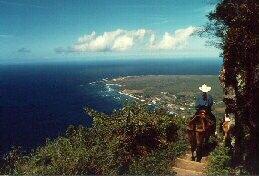About Kalaupapa, Moloka'i

About Kalaupapa, Moloka'i

Kalaupapa is a peninsula on the northern side of Moloka'i, separated form the rest of the island by cliffs two thousand feet high and accessible only by a switch back trail carved into the side of the mountains. This isolated peninsula was designated by the Hawaiian government as a kind of quarantine for those diagnosed as having leprosy. The first patients arrived in 1864 and settled in Waikolu Valley. Since that time, there have been six thousand exiles to Kalaupapa.
Armed with the barest necessities for survival, the early settles were left to fend for themselves. With the trauma of separation fresh in their minds, they arrived in a land where the majestic mountains and the pounding surf formed an inescapable trap with the only way out through a sealed coffin. The stark reality of the hopelessness of their future existence led many to a life of debauchery and sin, a way of forgetting the pain of their infirm bodies and the ache in their lonely hearts. Chaos, disorder, and moral degeneration was the scene in Kalaupapa when Father Damien arrived on May 10, 1873.
Through the years many improvements have been made to the physical appearance of the land. There are neat rows of cottages with fenced yards, running water, electricity, telephone, and cable T.V. Each week meats, vegetables, and other provisions are flown in. The daily newspaper is delivered when the first flight arrives from Honolulu.
The Kalaupapa settlement continues to be home to patients with Hansen's disease; now by choice, not by government decree. They are free to leave whenever they wish as the treated disease no longer poses a threat to society. As a result, no new cases are sent to Kalaupapa. Everyone with the disease is now treated on an outpatient basis. Eventually, the last person will leave and the peninsula will become a National Historic Monument under the supervision of the National Park Service.